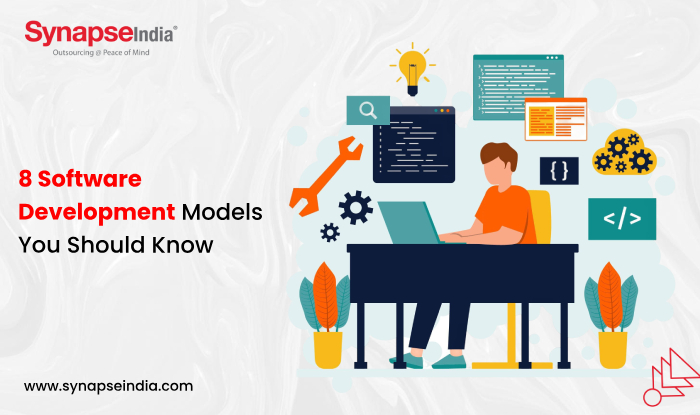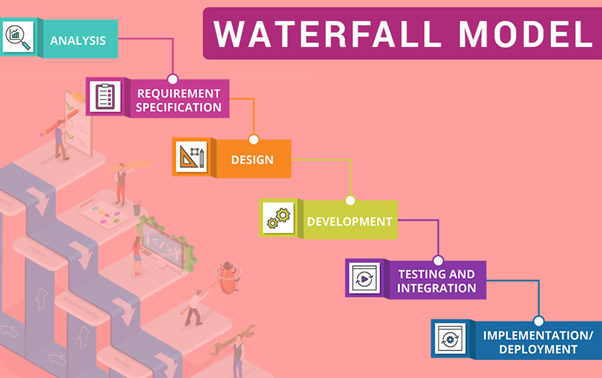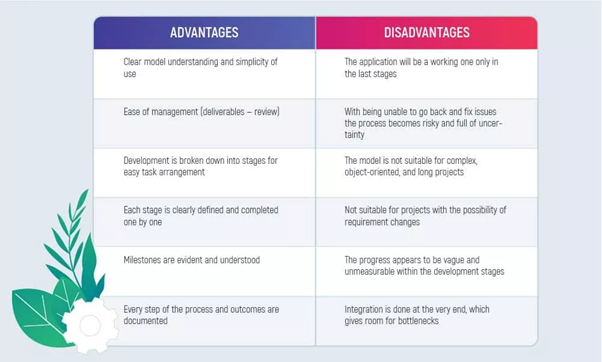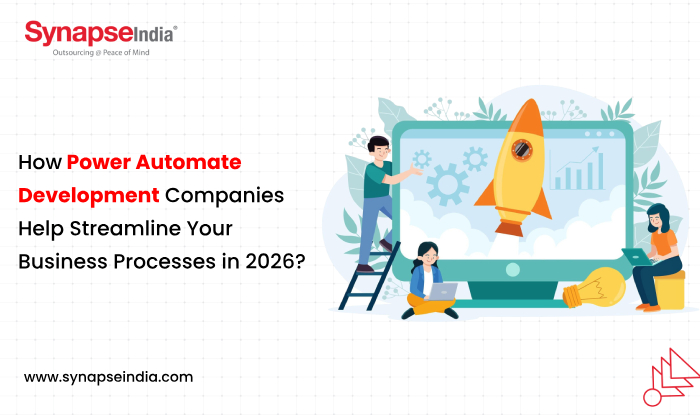 23 Apr 2022
23 Apr 2022
Developing high-quality, reliable software is a challenging task that demands a comprehensive and structured approach. Here comes the concept of software development life cycle (SDLC).
It can be defined as a framework followed by a team of software engineers that enables application development that meets requirements and deadlines and delivers value to their users.
So, we will discuss the 8 software development lifecycle models employed by developer teams. This article is based on the experience of SynapseIndia in building custom apps and software for years.
A software project development model is a range of processes and methodologies implemented for project development. There are many types of software development life cycle models that companies use to achieve their goals.
SynapseIndia ranks high among the best software development company. Tap maximum advantage of our domain expertise to boost your business efficiency and make unprecedented profits with the best technologies around the globe.
Factors that go into model selection include when to test, when to submit, what features must exist, and the like. Reliability, accuracy, ease of use, and level of technical difficulty are also essential factors when choosing a software project development model.
Your selected SDLC model is really important in software development for various reasons. It will dictate the direction and results achieved in a project from the beginning. Once you start with a model, it cannot be changed to another.
These are also the reasons why different companies often use different software development models for different projects. The scale of effort and timelines will definitely be a factor, particularly when dealing with clients who demand instant results. When it comes to skill level, models can change.
Read more: Importance of SDLC in effective software development
So, let's go ahead and discuss the 8 Software development life cycle models.
There are multiple software models available that companies can use to meet different requirements. Here's an in-depth look at the eight best software development models.

The waterfall software development model is a linear sequential flow, often used with projects that have a defined set of requirements. Reflecting its name, the model process flows steadily downward through the software implementation phases.
This model is based on the completion of the previous phase so that the next one begins. Because the model does not support going back to previously completed phases, the waterfall model should be used with projects that do not anticipate unforeseen changes mid-development.
The pros of the waterfall SDLC model are that it allows for departmentalization and control. A schedule with deadlines can be set for each stage of development and a product can progress through the phases of the development process model one by one.
Development goes from concept, through design, implementation, testing, installation, and troubleshooting, and ends with operation and maintenance.
Some of the pros of the waterfall model are as follows
The downside of waterfall development is that it doesn't allow much thought or review. Once an application is in the testing stage, it's very difficult to go back and change something that wasn't well documented or thought of in the concept stage.
The main cons of the waterfall model are the following:

Read more: How Technology helps startups to grow
.png)
The incremental software development model is not a separate model. It is necessarily a series of cascading cycles. Needs are divided at the beginning of the project development. For every divided group, the SDLC model is followed to develop software. The SDLC process iterates, with each release adding more features until all requirements are met. In this method, each cycle acts as the maintenance phase for the previous software version. Modifying the incremental model allows development cycles to overlap. After that, the subsequent cycle can start before the previous cycle is complete.
The Incremental Model is a great solution for projects that need to accommodate some change requests between increments. This model also offers the advantage of being able to detect problems earlier in software development for better lifecycle management planning.
A possible disadvantage of the incremental model is the need for strategic planning and documentation. This method also tends to require more resources, personnel, and money, behind the project. This model is not ideal for continuous development, as the next sequence cannot start until the previous stage has been fully completed.
.png)
The validation and verification software development model is a linear approach where each phase encompasses a corresponding test run. This model offers a great organization of the workflow, which translates into excellent quality control. However, the excellent workflow organization makes the V model one of the most expensive and time-consuming models in software development.
The model allows developers to detect defects and errors in the architecture, code, and requirements specification early. However, even though these errors and defects are caught early, making changes during the process is often challenging and even costly. It is also similar to the Waterfall model, as all the requirements are collected and summarized from the first stage but remain unchanged.
The V-shaped software development process model is the best option for small and medium-sized projects. Also, it works well when project requirements are clearly defined as it extends the waterfall model. Companies should go for the V-shaped model when they have ample technical resources, and their developers are technically sound.
Pros of Validation and Verification Model
The advantage of the Validation and Verification model is that it is very easy to understand and apply. The simplicity of this model also makes it easy to handle.
The advantages of the validation model are the following:

The waterfall software development model is a linear sequential flow, often used with projects that have a defined set of requirements. Reflecting its name, the model process flows steadily downward through the software implementation phases.
This model is based on the completion of the previous phase so that the next one begins. Because the model does not support going back to previously completed phases, the waterfall model should be used with projects that do not anticipate unforeseen changes mid-development.
The pros of the waterfall SDLC model are that it allows for departmentalization and control. A schedule with deadlines can be set for each stage of development and a product can progress through the phases of the development process model one by one.
Development goes from concept, through design, implementation, testing, installation, and troubleshooting, and ends with operation and maintenance.
Some of the pros of the waterfall model are as follows
The downside of waterfall development is that it doesn't allow much thought or review. Once an application is in the testing stage, it's very difficult to go back and change something that wasn't well documented or thought of in the concept stage.
The main cons of the waterfall model are the following:

Read more: How Technology helps startups to grow
.png)
The incremental software development model is not a separate model. It is necessarily a series of cascading cycles. Needs are divided at the beginning of the project development. For every divided group, the SDLC model is followed to develop software. The SDLC process iterates, with each release adding more features until all requirements are met. In this method, each cycle acts as the maintenance phase for the previous software version. Modifying the incremental model allows development cycles to overlap. After that, the subsequent cycle can start before the previous cycle is complete.
The Incremental Model is a great solution for projects that need to accommodate some change requests between increments. This model also offers the advantage of being able to detect problems earlier in software development for better lifecycle management planning.
A possible disadvantage of the incremental model is the need for strategic planning and documentation. This method also tends to require more resources, personnel, and money, behind the project. This model is not ideal for continuous development, as the next sequence cannot start until the previous stage has been fully completed.
.png)
The validation and verification software development model is a linear approach where each phase encompasses a corresponding test run. This model offers a great organization of the workflow, which translates into excellent quality control. However, the excellent workflow organization makes the V model one of the most expensive and time-consuming models in software development.
The model allows developers to detect defects and errors in the architecture, code, and requirements specification early. However, even though these errors and defects are caught early, making changes during the process is often challenging and even costly. It is also similar to the Waterfall model, as all the requirements are collected and summarized from the first stage but remain unchanged.
The V-shaped software development process model is the best option for small and medium-sized projects. Also, it works well when project requirements are clearly defined as it extends the waterfall model. Companies should go for the V-shaped model when they have ample technical resources, and their developers are technically sound.
Pros of Validation and Verification Model
The advantage of the Validation and Verification model is that it is very easy to understand and apply. The simplicity of this model also makes it easy to handle.
The advantages of the validation model are the following:
The disadvantage is that the model is not flexible to changes and in case there is a requirement change, which is very common in today's dynamic world, it becomes very expensive to make the change.
The cons of the validation and verification model are as follows:
-Model(1).png)
The Rapid Action Development (RAD) software development model was introduced in 1991 and served as the foundation for modern iterative frameworks. It focuses on getting products built in a much shorter time frame without compromising quality.
RAD is a 4-step framework, championing project requirements, prototyping, testing, and deployment. Unlike linear models, RAD emphasizes building prototypes with given requirements and testing them with the customer. This is done through multiple iterations until the client is satisfied with the results.
Rigorous prototype testing results in valuable feedback, helping to de-risk much of the product. The use of RAD generates high chances of successful product launches within the stipulated schedule.
The RAD model is highly recommended for software recommended by user interface-based requirements. In addition, the RAD model should be used when it is necessary to develop a system with modulation possibilities in 2-3 months.
The RAD model allows for reduced development time and allows for more customer feedback throughout software development.
The applicability of the RAD model is limited, as the project must be easily modularized in various increments. It also requires well-versed developers, as well as excellent modeling and planning skills. Problems with the final assembly of components could lead to unforeseen mishaps and reshaping of components to fit properly with the rest.
.png)
As the name suggests, the SDLC software development model is divided into several iterations and is based on the incremental model. In this case, new software models are added at each iteration with little or no charge to previously added models. The SDLC can be sequential or parallel. Multiple iterative development cycles make the project costly and time-consuming, while parallel development increases the speed of delivery. Since new software modules are added to the previous iteration, the development of the iteration implies changes in each iteration and the evolution of the development. However, the software design remains consistent as each iteration builds on the previous one.
From the beginning of the project, a proper specification is not required since the software product is divided in parts. Some changes to the requirements can also be made during the software development process. But it is important to define the necessary conditions from the beginning, even if the requirements cannot be changed completely. This is more important for systems in incremental development, as further integration of distributed parts of the software can be a problem.
In this model, it may be necessary to modify some minor requirements during the course of the development process. Therefore, the SDLC model needs some input from clients.
If the project is larger and more complex, using the iterative model maybe your best option. Developers need to ensure that the large complex project is broken down into modules for optimal use of the iterative model. In addition, it can also be used in systems with separate components, such as the ERP system.
.png)
The spiral software development model is a risk-driven process model. This SDLC model helps the group adopt elements of one or more process models such as waterfall, incremental, etc. The spiral technique is a combination of rapid prototyping and concurrence in design and development activities.
Each cycle of the spiral begins with the identification of objectives for that cycle, the different alternatives that are possible to achieve the goals, and the limitations that exist. This is the first quadrant of the cycle.
The next step in the cycle is to evaluate these different alternatives based on the objectives and constraints. The focus of the assessment in this step is based on the perceived risk to the project. The upcoming step is to build strategies that resolve risks and uncertainties. This step may involve activities such as simulation, benchmarking, and prototyping.
It has four stages or phases, the planning of objectives, the risk analysis, the engineering, or development, and finally the review. A project goes through all these stages repeatedly and the phases are known as Spiral in the model.
This phase includes the gathering and analysis of requirements. Based on the requirements, objectives are defined, and different solution alternatives are proposed.
Risk analysis and resolution:
In this quadrant, all proposed solutions are analyzed and any potential risk is identified, analyzed, and resolved.
Develop and test:
This phase consists of the actual implementation of the different features. All implemented features are then verified with extensive testing.
Review and planning of the next phase:
In this phase, the software is evaluated by the client. It also includes identifying and tracking risks, such as cost overruns or schedule delays, and then planning for the next phase begins.
.png)
The Big Bang software development model focuses all kinds of resources on software development and coding, with little or no planning. Requirements are understood and implemented when they arrive.
This model works best for small projects with smaller development teams working together. It is also useful for academic software development projects. It is an ideal model where the requirements are unknown, or the final release date is not given.
It is mainly used for academic software development projects or smaller projects where the development team is small and works closely together. It is useful when the requirements are unknown, and the release date is very flexible.
(6).png)
This process is the proper culmination of iterative and linear frameworks. This software development model divides the entire software development process into four different parts: Beginning, Expansion, Construction, and Transition. In this process, all the required activities of the development process are performed in parallel. It is the reason why this software development model helps to create flexible software solutions.
RUP is widely used on large, high-risk projects. Also, if you want high-quality software and a faster development process, the Rational Unified Process should be your SDLC model.
Choosing the right software development model for your project can be difficult. If you know your requirements well, it will be easier to select the model that best suits your needs. You should consider the following factors when selecting your software development model:
Before choosing a model, take some time to review the project requirements and clarify them along with the expectations of your organization or team. Will the user need to specify the requirements in detail after each iterative session? Will the requirements change during the software development process?
This implies the knowledge and experience of the developers with the domain of the project, the software tools, the language, and the methods necessary for the development.
Need to consider the size of the project you are working on. Bigger projects mean bigger teams, so you'll need more extensive and elaborate project management plans.
To choose between different software models is an important step in product development. Models give you the ways and means to achieve your goal when working on a project and provide clear instructions, methods on how to achieve your goal, and solutions when trying to fix problems. With the major software development models provided above, you should be quite equipped to dive into your project head-on. If in your case, you have any queries related to it, you can Contact Us! without thinking twice. Our experts will help you.
Read more: 6 Stages of Software Development Process

 23 Apr 2022
23 Apr 2022
